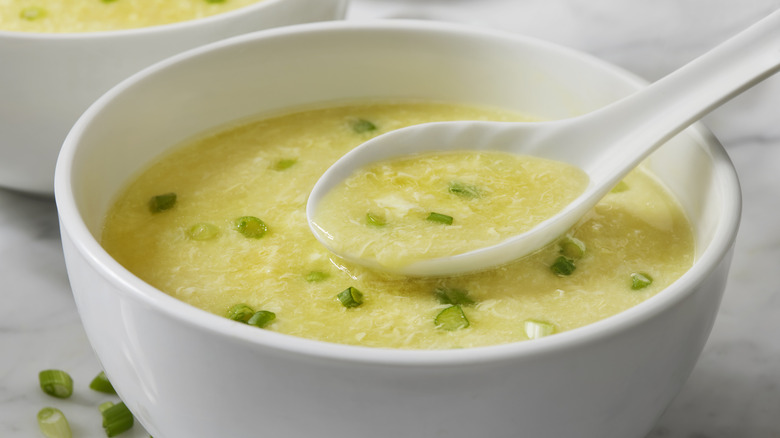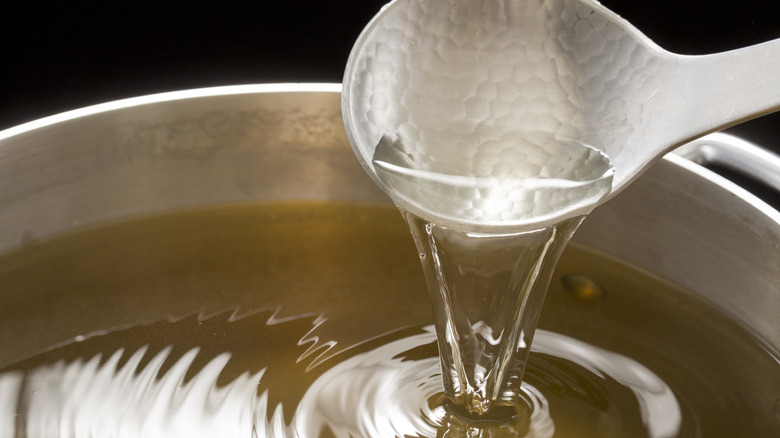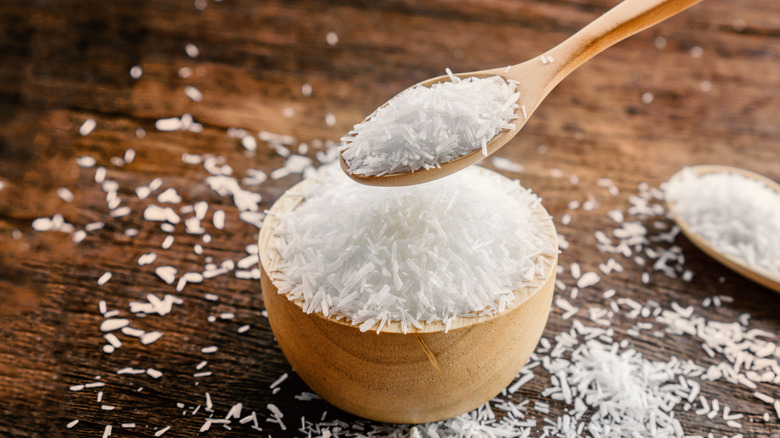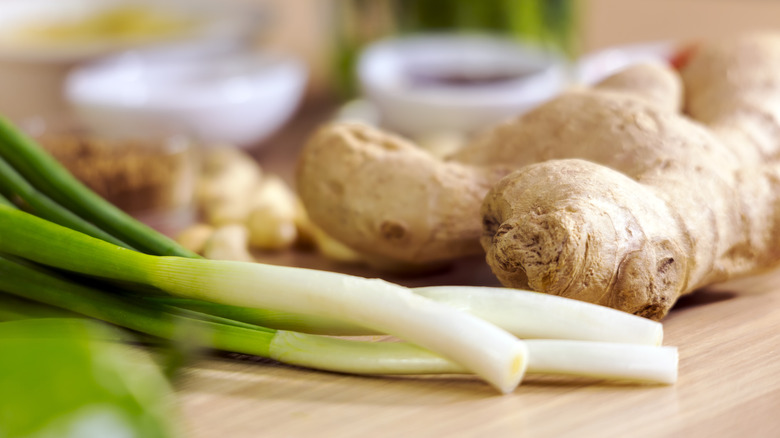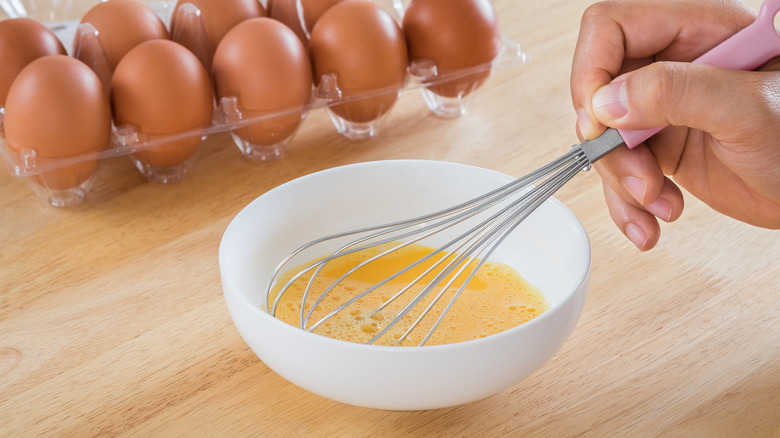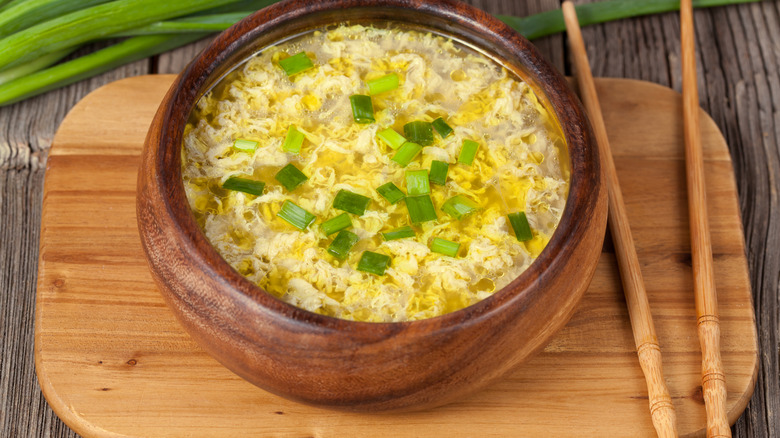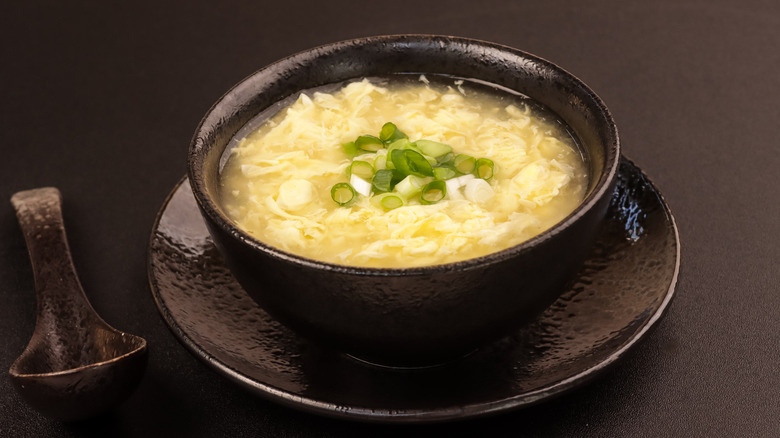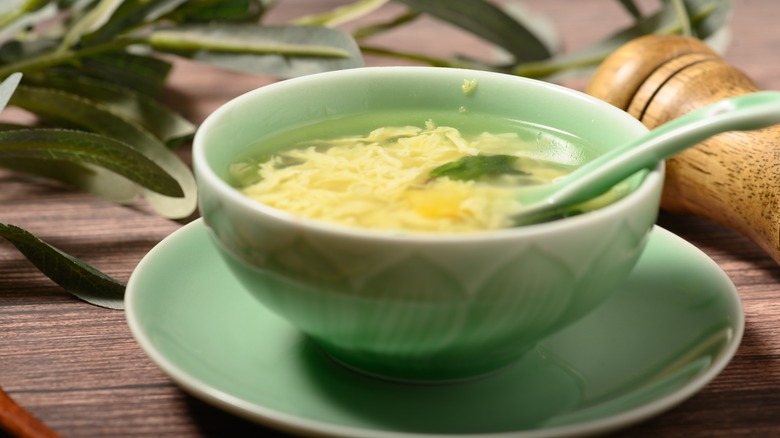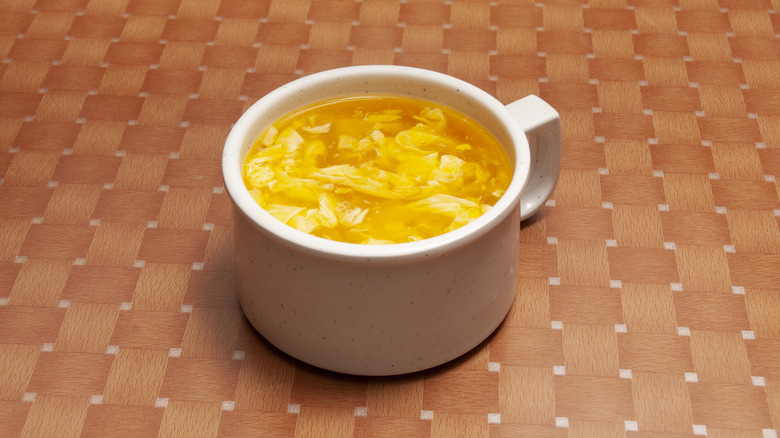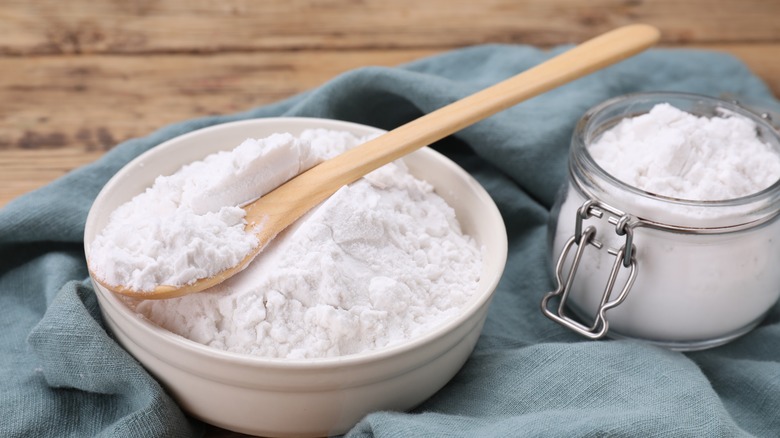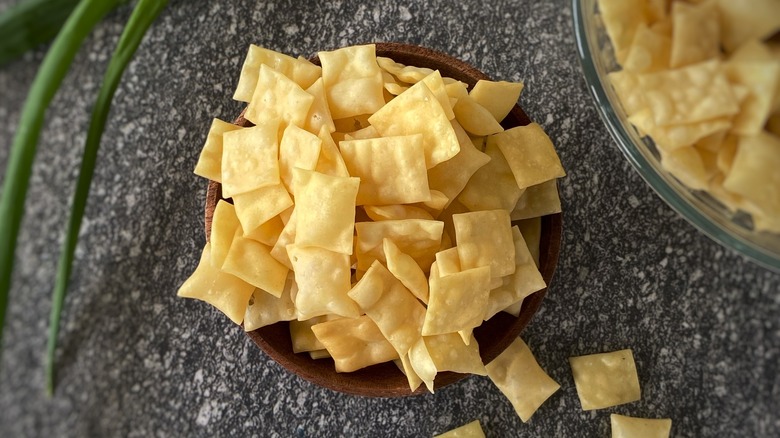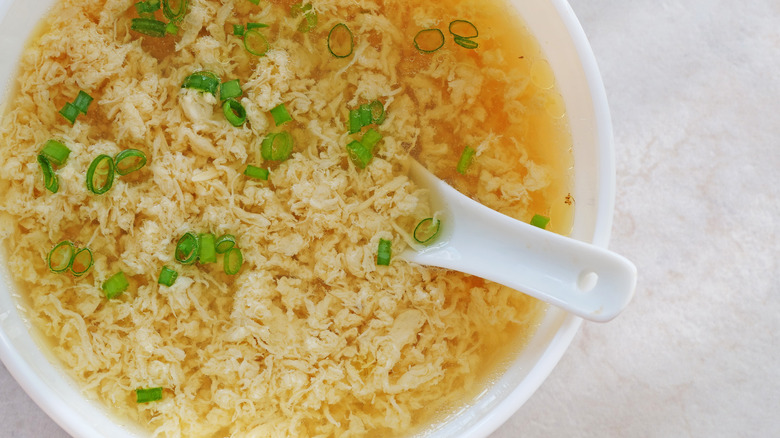Why Egg Drop Soup Always Tastes Better At A Restaurant Than At Home
It's easy to see why egg drop soup is on every table at many Chinese American restaurants: It's not only fast and easy to make with staples that every well-stocked restaurant kitchen has on hand, its mild flavor and familiar ingredient list make it appealing even to the most timid palates. This is why it's often among the first Chinese dishes many Americans taste — and a dish that seems accessible and simple enough to try at home.
But as many of us have found, reproducing restaurant-style egg drop soup at home isn't as simple as it looks. It's all too easy to end up with a bowl of watery broth with scrambled egg clumps rather than the rich, velvety concoction we enjoy when dining out. While restaurant cooks can throw together a pot of egg drop soup quickly, quick does not mean easy or carefree. The Chinese name for the dish is "egg flower soup," and the eggs are intentionally added in a way that transforms them into delicate flakes and strands, like petals of flowers. Here are some expert tips for making restaurant-quality egg drop soup at home.
Restaurants use a better soup base
In Chinese cuisine (as also in French cuisine) good stocks and soup bases are of paramount importance – so much so chefs set aside part of each work day to make their soup base. In many classic Chinese soups, including special-occasion preparations featuring pricy ingredients such as sharks' fin and birds' nest, the soup base provides virtually all the flavor — the fancy ingredients are nearly tasteless, and serve mostly to soak up the flavorful broth.
And even in everyday dishes such as egg drop soup, the quality of the soup base matters. Swirling raw eggs into a pot of heated canned broth simply will not do. "A great soup always starts with a rich and flavorful soup base," advises chef and blogger Jessica Chan. "High-quality chicken broth made from scratch is a must!" says Philippe Chow, chef-owner of Philippe by Philippe Chow in New York. The moral is if you want restaurant-quality egg drop soup, you need to plan ahead and make your own soup base.
MSG gives many restaurant soups extra flavor
If you've wondered why egg drop soup at restaurants has that extra savoriness and oomph that you never manage to achieve at home, there's a simple three-letter answer: MSG. And we're here to tell you it's not the dietary menace you may believe it to be. "Contrary to the misconception about MSG (monosodium glutamate), this additive is found in natural foods such as tomatoes, mushrooms, and cheese," says chef Jessica Chan.
Indeed, studies have disproven the widespread disbelief that MSG can cause headaches and other ailments. While a handful of people have negative reactions to glutamates in general, this is a rare condition that need not worry most of us. And even if you avoid using MSG in your own cooking, you're probably consuming more of it than you think, and not just in Chinese restaurants. Common foods such as flavored chips, cold cuts, and canned soups all contain MSG. So if you've been enjoying these without discomfort, a touch of MSG in your homemade egg drop soup wouldn't hurt.
A smart choice of seasonings make a huge difference
There's more to egg drop soup than meets the eye. What appears to be a simple bowl of broth laden with tender egg strands is actually an intentional blend of seasonings meant to enhance the soup's flavor without overwhelming the delicate eggs. "Egg drop soup is usually made with chicken broth and is often enhanced with aromatics like ginger, garlic, and scallions," says chef and blogger Jessica Chan. "Condiments such as salt, sugar, sesame oil, and white pepper are added to balance the flavors."
These quintessentially Chinese flavorings lend egg drop soup its signature taste, and no proper bowl of restaurant-quality soup can be made without them. "Many restaurant versions of egg drop soup include a dash of sesame oil as well as fresh ginger," chef Philippe Chow explains, "and both of these are sometimes skipped in homemade versions." So if you're wondering why your homemade egg drop soup lacks that special something, these ingredients may be the missing piece to your puzzle.
How you beat your eggs matters
A defining feature of a good bowl of egg drop soup is the delicate texture of the eggs — they emerge as fine strands or tiny, thin sheets evenly distributed throughout the soup, where they add body and absorb the flavor of the broth. As the name of the soup implies, these threads are the result of beaten eggs being dropped into hot broth, where they cook almost instantly into the familiar threads.
To get your eggs to cook to the right consistency, however, requires a bit of finesse. If you simply dump beaten eggs into hot broth and stir, you're setting yourself up for disappointment. To ensure your eggs come out as threads rather than clumps, chef Jessica Chan advises that you beat them thoroughly. "You first want to beat the eggs until the yolk and white are homogenized," she explains. "Next, strain the eggs using a sieve for a smoother silky texture." And Philippe Chow, chef and restaurant owner, adds that beating eggs to "a smooth, uniform texture" is the key to delicate egg threads.
The right temperature is critical for delicate egg threads
Another factor that home cooks often overlook when making egg drop soup is the temperature of the broth: To get the dainty egg threads that define the dish, you should ensure the broth is warm, but not aggressively hot, when you add the eggs. Soup that is actively boiling or even simmering can damage the eggs. "Don't add the eggs while the broth is boiling vigorously, which can cause the eggs to break into small pieces instead of forming those signature ribbons," advises chef Philippe Chow.
Some home cooks may stir their eggs into simmering or boiling broth because they fear the eggs wouldn't cook otherwise, but this fear is misguided. Whole eggs actually coagulate at a surprisingly low temperature — 156 degrees Fahrenheit. This is far below the 212-degree (Fahrenheit) boiling point for water. So while you may need higher temperatures to make your soup base and infuse it with flavorings, be sure to turn down the heat before you add your eggs. "Before drizzling in the beaten eggs, reduce the heat to low," says chef and blogger Jessica Chan.
Here's how the experts add eggs to their soup
The name egg drop soup can be deceiving, since it suggests that all cooks need to do is drop beaten eggs into the soup. But if you've done this at home, you know it yields very different results from what you'd get at a restaurant. To get restaurant-level egg drop soup, you need to use the same techniques the restaurants use to introduce the eggs into the soup base.
While these techniques are not difficult, they require attention and patience. "When adding eggs to egg drop soup, you want to go low and slow," chef Jessica Chan says. "Transfer the eggs to a measuring cup with a spout for better control. Using a spoon or spatula, stir the soup in one direction to create a whirlpool then slowly drizzle in the eggs to form thin, silky ribbons." Chef Philippe Chow employs the same technique. "Pour the beaten eggs slowly into the hot broth while stirring gently in one direction. This creates the signature egg ribbons or strands," he advises.
These tasty add-ins make egg drop soup extra hearty
One of the pleasures of egg drop soup is its simplicity: At its most basic, it's just soup base and eggs. Since it's usually served as a light appetizer before a meal that may include multiple courses, this simple version is plenty satisfying — light and flavorful enough to whet the appetite without overwhelming the palate or filling you up. But on occasion, you might want your soup to have a bit more substance, especially if you're making it at home and making it the main course of a weekend lunch.
Fortunately, you have plenty of easy options. Variations on egg drop soup abound in traditional Chinese restaurants, and add-ins to provide extra heft and flavor are common. Those that best complement the soup tend to be mildly flavored themselves. "Sweet corn kernels are a great addition to egg drop soup," chef Jessica Chan says. "The sweetness of the corn complements the chicken broth and egg deliciously. You can use canned corn or fresh corn. Silken tofu adds texture and makes the egg drop soup heartier." In addition, restaurant owner and chef Philippe Chow recommends shrimp as another tasty add-in.
A touch of food coloring makes restaurant soup look richer
It's no secret that we eat with our eyes as well as our tongues and tummies. While we may happily eat a drab-looking dish that smells amazing, the visual presentation of a dish can make or break its success among diners. If you're used to enjoying egg drop soup in restaurants, you may have come to associate its presentation — in a small, deep bowl with a traditional Chinese soup spoon — with the dish itself. For this reason, making it at home and presenting it with your everyday bowls and spoons doesn't feel quiet as satisfying.
But short of visiting the cookware section of your local Asian grocery, you can take a simple step to make your home-cooked egg drop soup look a bit more like the one served in your favorite restaurant: Add a touch of yellow food coloring or a sprinkle of turmeric. This will give your soup the sunny hue seen in some restaurant soups. This is totally optional and doesn't add any flavor — but it can make your soup look a bit richer and more festive.
Cornstarch is the secret to a velvety broth
Eggs aren't the only ingredient that define the distinctive texture and mouthfeel of egg drop soup. Much of the soup's thick, velvety consistency comes from an ingredient most diners don't notice. "For that slightly thickened soup consistency, cornstarch is added in the final step," says chef and blogger Jessica Chan. While both cornstarch and flour are used in Chinese cooking, cornstarch works better as a thickener in egg drop soup because it turns transparent as a cooks. This means the broth will remain attractively clear even after it's thickened.
To thicken egg drop soup with cornstarch, first mix the cornstarch with water to form a slurry. The cornstarch in the slurry tends to separate and sink quickly, so add the mixture to the pot of simmering broth and stir vigorously before this happens. Keep stirring to ensure the broth stays smooth and no starchy clumps form. Once it has reached your desired level of thickness, add the eggs.
Try these toppings on your soup for crunch and color
Egg drop soup is a comforting pleasure, but it may not be the best choice if you're in the mood for excitement. If you order a basic egg drop soup, you'll get a simple, mildly flavored bowl of yellow soup with a mostly uniform texture. Even the most common add-ins — ingredients such as corn kernels and tofu — are close to the same color as the soup itself.
One way restaurants liven up their egg drop soup is with a range of garnishes. Sliced scallions offer a pleasantly sharp flavor accent as well as a pretty color contrast to the yellow soup. An even fancier garnish that differentiates restaurant soups from homemade versions is strips of fried wonton skins. These crunchy golden ribbons not only look pretty atop a bowl of soup, they add a welcome textural contrast. To make them, cut wonton skins into thin strips, deep fry them until they turn blistered and golden, and drain them on paper towels. Make plenty, since the strips are also great in salads, such as our deconstructed egg roll in a bowl.
Avoid these common mistakes when making egg drop soup
Like many classic dishes, egg drop soup is more than the sum of its parts. While its basic ingredient list is short and simple — just seasoned chicken stock, eggs, and a touch of cornstarch — making the soup correctly requires care. This is because none of the ingredients have anywhere to hide, so it's the cook's responsibility to blend them harmoniously and ensure each is at its best. However, the techniques to achieve this can be far from obvious to home cooks trying to reproduce their favorite versions in their own kitchens.
Our experts offer helpful warnings about some of the missteps they've encountered. One of the most frequent errors is the temptation to rush through the recipe. "A common mistake when making egg drop soup is adding the beaten eggs too fast, which often results in clumps of eggs," chef Jessica Chan says. Instead, she advises pouring the eggs in a thin, steady stream to ensure a delicate texture. Another common mistake is to underestimate the importance of a well-seasoned broth — because the broth provides almost all the flavor. "Remember to properly season the soup before adding the eggs," urges chef and restaurant owner Philippe Chow.

